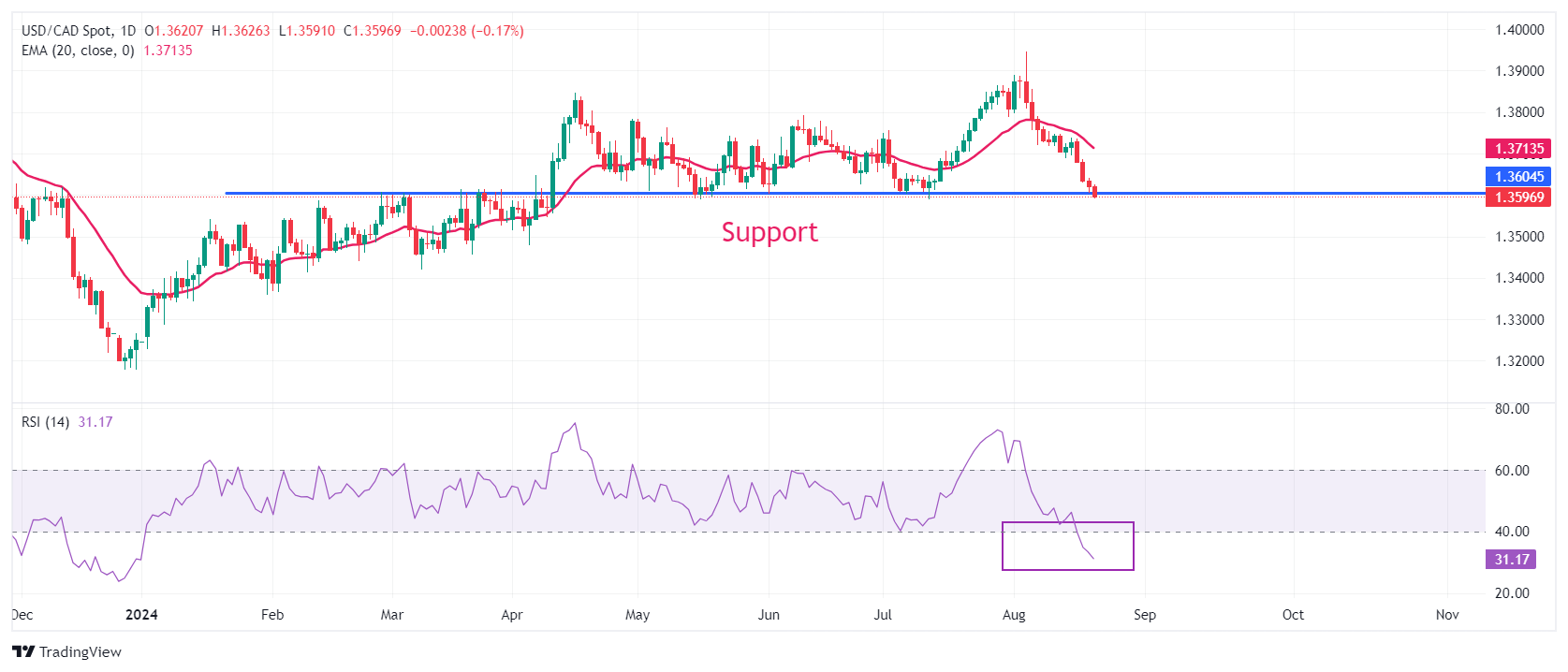- Analytics
- News and Tools
- Market News
- USD/CAD Price Analysis: Extends losing spree for fourth session ahead of FOMC minutes
USD/CAD Price Analysis: Extends losing spree for fourth session ahead of FOMC minutes
- USD/CAD extends its losing streak for the fourth trading session on Wednesday.
- Investors await the FOMC minutes for fresh interest rate cues.
- The Canadian Dollar outperforms despite multiple headwinds.
The USD/CAD pair tests territory below the round-level support of 1.3600 in Wednesday’s North American session. The Loonie asset weakens as the Canadian Dollar (CAD) outperforms the US Dollar (USD) despite multiple headwinds.
Investors underpin the Canadian Dollar even though the Oil price has fallen on the backfoot amid growing speculation of a ceasefire between Iran and Israel and easing price pressures have prompted expectations of more interest rate cuts by the Bank of Canada (BoC).
Meanwhile, the US Dollar Index (DXY), which tracks the Greenback’s value against six major currencies, hovers near 101.30, the lowest level seen in more than seven months. Going forward, the US Dollar will be influenced by the Federal Open Market Committee (FOMC) minutes, which will be published at 18:00 GMT.
Later this week, Fed Chair Jerome Powell’s speech at the Jackson Hole Symposium will be keenly watched by investors to get fresh cues about the interest rate path. Fed Powell will less likely provide a pre-defined rate cut path but might show comfort to market expectations, pointing to a move towards policy-normalization in September.
USD/CAD exhibits vulnerability near the horizontal support plotted from February 28 high near 1.3600. The asset is under pressure as the 20-day Exponential Moving Average (EMA) near 1.3714 is sloping downwards.
The 14-day Relative Strength Index (RSI) oscillates in the bearish range of 20.00-40.00, suggesting a firm downside momentum.
More downside would appear if the asset breaks below April 9 low of 1.3540. This would drag the asset towards the psychological support of 1.3500, followed by March 21 low of 1.3456.
In an alternate scenario, a recovery move above August 12 high of 1.3750 would drive the asset toward the round-level resistance of 1.3800 and April 17 high near 1.3840.
USD/CAD daily chart
Canadian Dollar FAQs
The key factors driving the Canadian Dollar (CAD) are the level of interest rates set by the Bank of Canada (BoC), the price of Oil, Canada’s largest export, the health of its economy, inflation and the Trade Balance, which is the difference between the value of Canada’s exports versus its imports. Other factors include market sentiment – whether investors are taking on more risky assets (risk-on) or seeking safe-havens (risk-off) – with risk-on being CAD-positive. As its largest trading partner, the health of the US economy is also a key factor influencing the Canadian Dollar.
The Bank of Canada (BoC) has a significant influence on the Canadian Dollar by setting the level of interest rates that banks can lend to one another. This influences the level of interest rates for everyone. The main goal of the BoC is to maintain inflation at 1-3% by adjusting interest rates up or down. Relatively higher interest rates tend to be positive for the CAD. The Bank of Canada can also use quantitative easing and tightening to influence credit conditions, with the former CAD-negative and the latter CAD-positive.
The price of Oil is a key factor impacting the value of the Canadian Dollar. Petroleum is Canada’s biggest export, so Oil price tends to have an immediate impact on the CAD value. Generally, if Oil price rises CAD also goes up, as aggregate demand for the currency increases. The opposite is the case if the price of Oil falls. Higher Oil prices also tend to result in a greater likelihood of a positive Trade Balance, which is also supportive of the CAD.
While inflation had always traditionally been thought of as a negative factor for a currency since it lowers the value of money, the opposite has actually been the case in modern times with the relaxation of cross-border capital controls. Higher inflation tends to lead central banks to put up interest rates which attracts more capital inflows from global investors seeking a lucrative place to keep their money. This increases demand for the local currency, which in Canada’s case is the Canadian Dollar.
Macroeconomic data releases gauge the health of the economy and can have an impact on the Canadian Dollar. Indicators such as GDP, Manufacturing and Services PMIs, employment, and consumer sentiment surveys can all influence the direction of the CAD. A strong economy is good for the Canadian Dollar. Not only does it attract more foreign investment but it may encourage the Bank of Canada to put up interest rates, leading to a stronger currency. If economic data is weak, however, the CAD is likely to fall.
© 2000-2025. All rights reserved.
This site is managed by Teletrade D.J. LLC 2351 LLC 2022 (Euro House, Richmond Hill Road, Kingstown, VC0100, St. Vincent and the Grenadines).
The information on this website is for informational purposes only and does not constitute any investment advice.
The company does not serve or provide services to customers who are residents of the US, Canada, Iran, The Democratic People's Republic of Korea, Yemen and FATF blacklisted countries.
Making transactions on financial markets with marginal financial instruments opens up wide possibilities and allows investors who are willing to take risks to earn high profits, carrying a potentially high risk of losses at the same time. Therefore you should responsibly approach the issue of choosing the appropriate investment strategy, taking the available resources into account, before starting trading.
Use of the information: full or partial use of materials from this website must always be referenced to TeleTrade as the source of information. Use of the materials on the Internet must be accompanied by a hyperlink to teletrade.org. Automatic import of materials and information from this website is prohibited.
Please contact our PR department if you have any questions or need assistance at pr@teletrade.global.
















